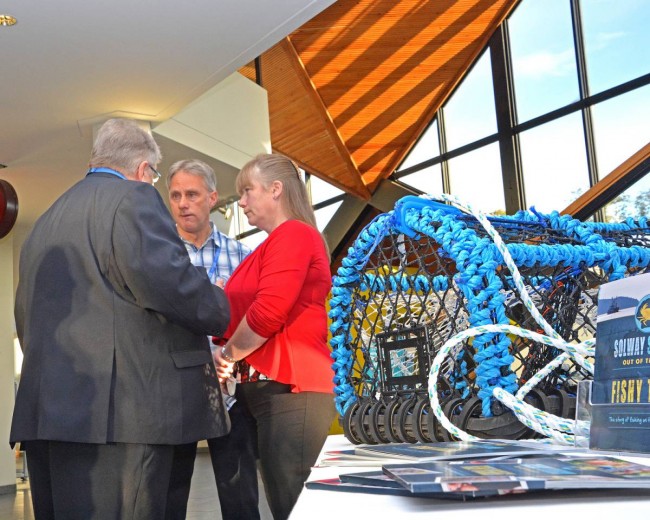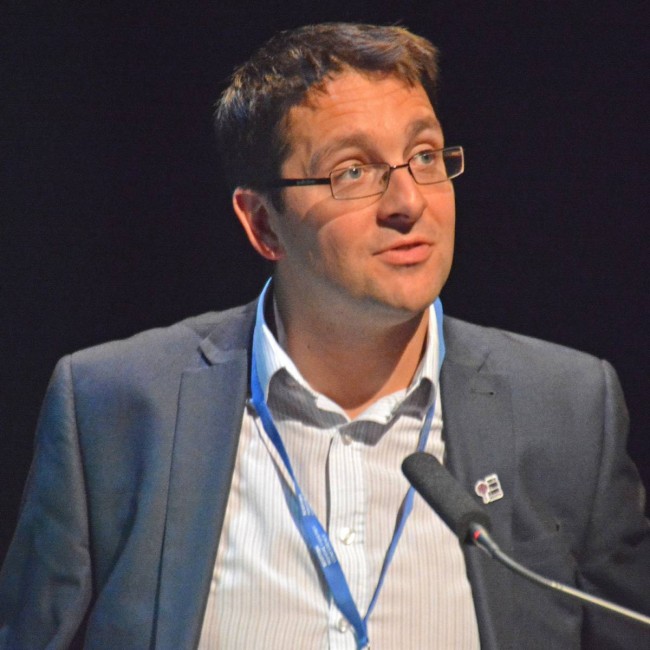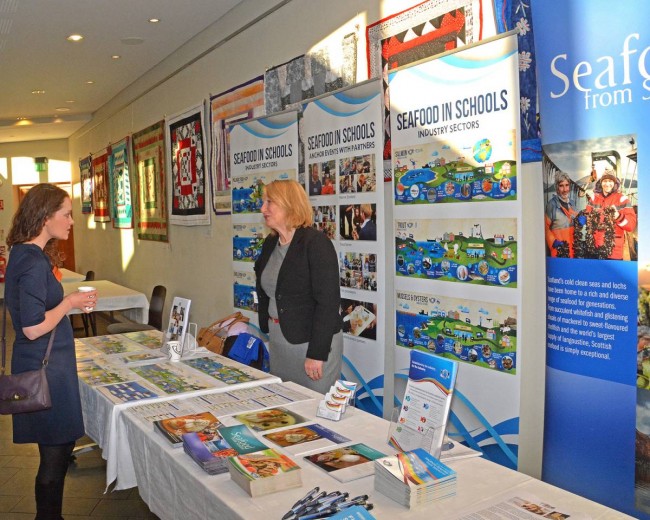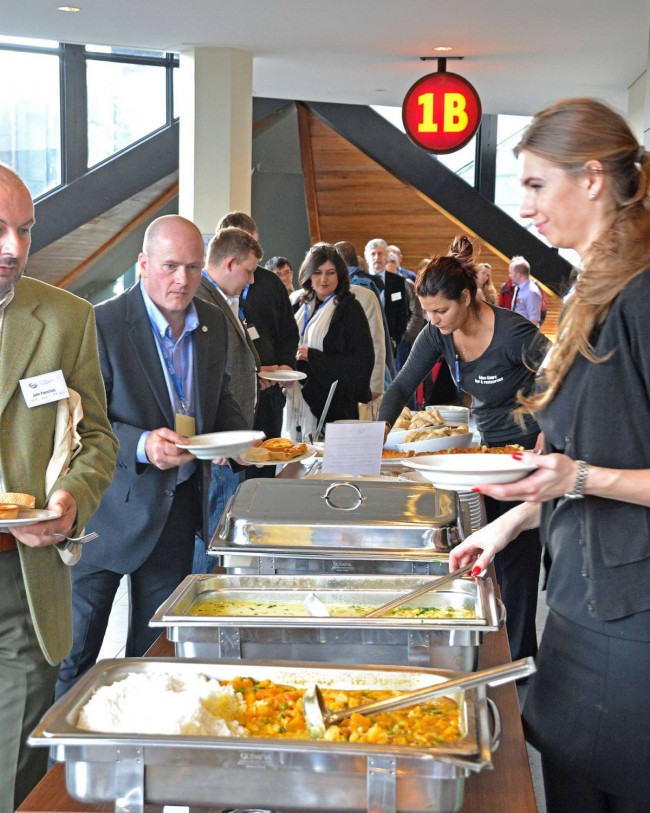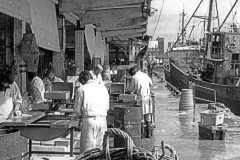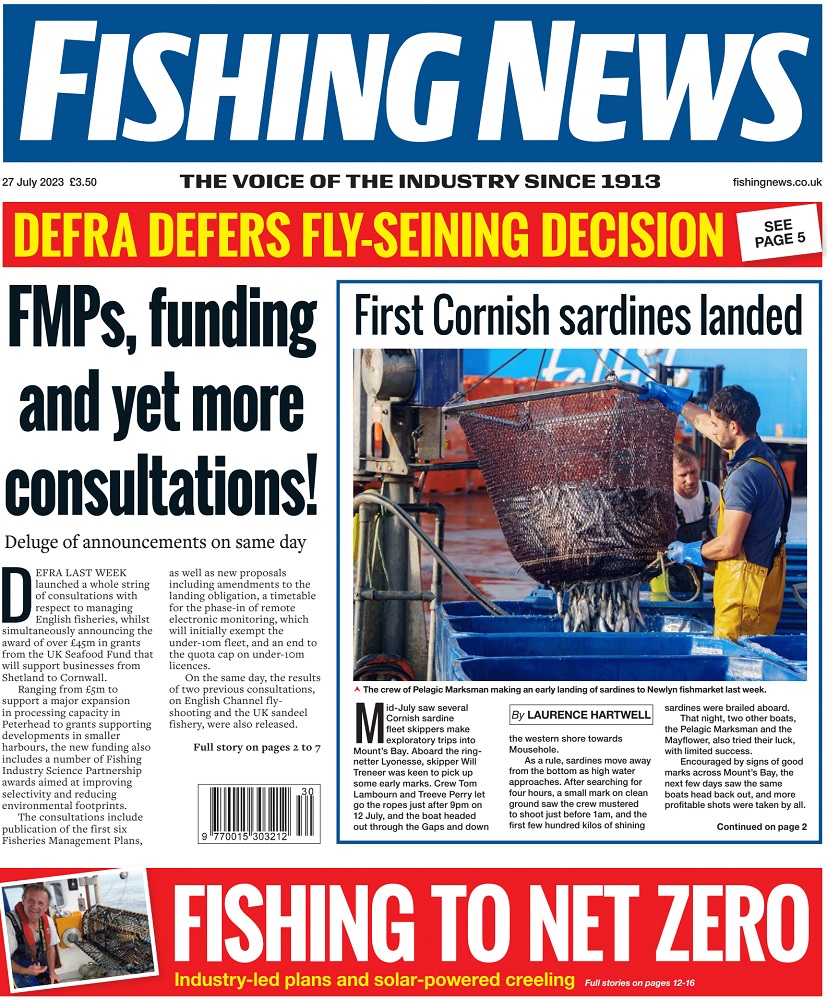Around 130 delegates from a wide cross-section of industries and organisations related to inshore fisheries made their way to Inverness for the third Scottish Inshore Fisheries Conference (SIFC) in mid-October. The timing of the event was especially relevant, being both in the Scottish Year of Food and Drink and on the first day of Seafood Week, and the celebration of the excellence of Scottish seafood products became the underlying theme of the day. Kelvin Boot reports.
Above: The third SIFC provided ample opportunity to renew old acquaintances and make new contacts.
Common interest
In his welcoming remarks, Mark Palmer, Head of Sea Fisheries at Marine Scotland, highlighted the value of bringing together a group that, while diverse, had the success of Scottish inshore fisheries as a common interest, so that they could learn from each other, get points of view across and network. “One of our key priorities in the strategy that we have for the inshore fisheries is to improve engagement and the connections with all involved in inshore fisheries and fishermen”.
Feedback from the conference delegates shows that aim was achieved.
Mike Palmer also noted that it was “an opportunity for all those involved in inshore fisheries to have access and engagement to decision makers, to those who are developing policy for fisheries management for the inshore.”
That set the tone for the keynote speaker, Cabinet Secretary for Rural Affairs, Food and the Environment, Richard Lochhead MSP.
“People around the world are willing to pay a premium for Scottish seafood”
Casting his gaze around the audience Mr Lochhead noted that among those present were fishermen, fish processors, NGOs, public sector and community representatives, as well as government, educationalists and seafood chefs, indeed from the many sectors interested in inshore fisheries and their future.
Scottish food and drink, he noted, was a major success story, with growth larger than any other sector in Scotland. With new markets opening up across the world, exports are up 57% since 2007, retail sales are up by over a third, while targets set for the sector in Scotland have been exceeded six years ahead of schedule, with a turnover of over £14billion.
At the heart of this are the ‘primary producers’, the farmers and fishermen often working in difficult conditions to produce the quality raw materials that underpin the wider food and drink industry. Scottish seafood businesses, in particular, are playing a leading role in building Scotland’s reputation and exports are rocketing, with seafood playing a crucial role. “Scottish provenance was key to the success”, he said. “People around the world are willing to pay a premium for Scottish seafood”.
Set against the Cabinet Secretary’s stated commitment to support inshore fisheries, he made a number of announcements including: his intention to press for reforms to the Inshore Fisheries Groups, revisions to the Inshore Fisheries Strategy, and a continuation of the hand-line mackerel trial, which made an increase of 1000 tonnes of quota available to the inshore fleet, for a further two years, to be followed by a review.
Mr Lochhead’s presentation ended with a vigorous Q&A session which included Marine Protected Areas, which he placed in their national and international obligation context, but he recognised that there are concerns for the industry, and pointed out that further evidence was being taken and more, and better, information was being sought.
Members of the audience added that the impacts of any decisions on local communities should be considered alongside the science.
Other topics included: how fisheries decisions are reached, support for jobs within the fishing industry and the status and profile of the industry in Scotland. A key theme that developed throughout the day was that of participation by fishermen, and the need for them to become more involved at all levels; indeed, the conference itself was an example of exactly how that can be achieved.
Complex supply chain
Working fishermen may be the mainstay of the industry, but they are only one part of a supply chain so it was essential to get input from elsewhere in that chain.
Immediately after lunch, the main talk was given by James Withers, Chief Executive of Scotland Food and Drink, who introduced chef and restaurant owner Adam Newth, and Kevin MacGillivray from the MacDonald Hotels chain, who both gave their perspectives on sourcing local sea foods.
Adam Newth spoke with pride about the quality of Scottish seafood and how it has always been a major part of his development as a chef, and the key part it played in his restaurant. Kevin, who is responsible for the food in a chain of 45 hotels, pointed out that while it was difficult to use single small suppliers, he had a policy of using local suppliers and producers where possible, and said that all their fish was wild-caught, apart from salmon. The importance of quality local fish has become very important to the Scottish economy.
James Withers added that Scottish food and drink is responsible for employing one in six people in Scotland, and is the second most important issue when it came to why people visited Scotland. Scottish fish is now the second most important food product for the public in Scotland. Scotland is recognised as a place to get world class products, and that includes fish, with Scottish fish-based restaurants and their chefs now amongst the best in the world.

David Bailey, from the University of Glasgow, discussing the potential for Community Supported Fisheries.
Breaks and breakouts
The structure of the day was designed to maximise the opportunities for networking across the industry, and to pursue further questioning of the speakers, including the Cabinet Secretary.
In keeping with the celebration of Scottish Food and Drink, it was fitting that the unashamedly fishy lunch ingredients were locally-sourced and the menus designed by Scottish award winning chef Adam Newth, the 2013 ‘Young Scottish Seafood Chef of the Year’ and ‘Young Scottish Chef of the Year’.
There was a real buzz during these intervals, with delegates gathering in small groups for passionate discussions about their industry or taking the opportunity to visit the dozen or so stalls in the foyer to ask even more detailed questions, to get an idea of how others fit into Scottish inshore fisheries, and once more discover how working together pays dividends.
Breakout sessions held before and after lunch provided forums for more detailed discussion and exchange of opinions and experiences around four topics.
Local fish for local people
The first breakout session became a discussion forum for developing local markets, with suppliers and consumers sharing ideas.
Busy chefs don’t have a lot of time for finding new sources of fish, while fishermen highlighted the problems of not being able to supply in bulk to the larger chains, something that is much easier with small restaurants. Consistency of supply of certain species can also be unpredictable at certain times of year, so even more flexibility from chefs would be helpful.
Chefs did agree that knowing that fish is genuinely local to Scottish waters is a strong ‘brand’. There was a suggestion that some kind of Scottish seafood ‘hub’ could be set up for local markets. Other aspects that might work against local fishermen supplying local restaurants, included the problems from unlicensed and hobby fisherman, issues of compliance when it comes to selling fish, especially shellfish, and traceability.
Another breakout session looked at ways that community-supported fisheries might become established, even looking at ways that ‘fish boxes’ could be used as a method of giving customers lower prices and fishermen higher prices by cutting out ‘middlemen’. Like the now well-established ‘vegetable boxes’, the idea is to supply direct to customers and provide an opportunity to change eating habits by supplying some of the by-catch species that have not been popular with consumers, simply because they are unfamiliar.
Whether discards could move through the supply chain in this way caused a lot of discussion, and once more the challenges of food standards compliance were raised.
The session convenors, from the University of Glasgow, used this breakout to test their ideas among the delegates, and while there was a general support for bringing suppliers (fishermen) and end consumers together, there was some scepticism as to exactly how it might work, and more work was needed to fully understand all of the issues.
Processors’ perspective
Whatever the aspirations might be for the future, it is processors who still play a major role in Scotland’s fishing industry, so it is not surprising that a discussion panel with processors was a popular choice among delegates.
Once more the issue of communication between the different but connected parts of the supply chain was seen as a priority, with the suggestion that fishermen should visit processors to understand the challenges they face, to understand how value might be added to catches, what kind of expectations were reasonable and, most importantly, how catching and processing could be more integrated.
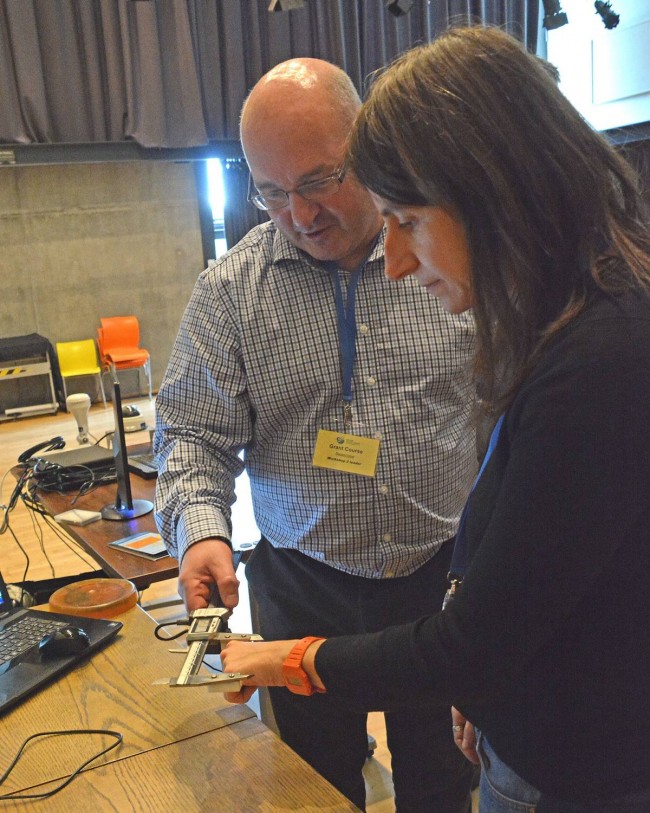
Bluetooth electronic callipers proved an efficient and cost-effective measuring device used by fishermen during scientific studies.
After the strong reminders of the Scottish fisheries ‘brand’ and the importance the fishing industry plays in Scotland, a natural topic for discussion was accreditation of catch location (Scottish origin) and quality of fish caught. Accreditation, it was agreed, should be awarded to skippers as opposed to vessels, it should be independent and robust and be scientifically endorsed.
Science makes sense of fisheries
Using science was the topic at the fourth breakout session, when results of two pilot EFF Inshore Fisheries Projects were presented.
These projects, managed through Seascope Ltd, have been highlighted before in Fishing News, and showed that scientific monitoring, including on-board cameras, not only provides valuable data that can be used in assessments and stock management in the future, but also validates the catch statistics supplied by skippers.
The skippers who took part in the research were very enthusiastic, and again the message was clear – working together can work to mutual benefit, in this case scientists and fishermen.
Was it a successful conference?
The ‘buzz’ on the day, the enthusiastic questioning and vigorous discussions, as well as post-conference feedback, suggest it was. Much progress had been made since the previous conference, but there is still more to do. The organisers, the Marine Alliance for Science and Technology for Scotland and Marine Scotland, encouraged by the positive feedback from delegates at the first three SIFCs, have already set their thoughts on similar future events that bring together delegates from across Scotland’s thriving inshore fisheries sector.
The full SIFC report can be viewed at gov.scot, by searching for SIF.
Read more from Fishing News here.


Around 130 delegates from a wide cross-section of industries and organisations related to inshore fisheries made their way to Inverness for the third Scottish Inshore Fisheries Conference (SIFC) in mid-October. The timing of the event was especially relevant, being both in the Scottish Year of Food and Drink and on the first day of Seafood Week, and the celebration of the excellence of Scottish seafood products became the underlying theme of the day. Kelvin Boot reports.
Above: The third SIFC provided ample opportunity to renew old acquaintances and make new contacts.
Common interest
In his welcoming remarks, Mark Palmer, Head of Sea Fisheries at Marine Scotland, highlighted the value of bringing together a group that, while diverse, had the success of Scottish inshore fisheries as a common interest, so that they could learn from each other, get points of view across and network. “One of our key priorities in the strategy that we have for the inshore fisheries is to improve engagement and the connections with all involved in inshore fisheries and fishermen”.
Feedback from the conference delegates shows that aim was achieved.
Mike Palmer also noted that it was “an opportunity for all those involved in inshore fisheries to have access and engagement to decision makers, to those who are developing policy for fisheries management for the inshore.”
That set the tone for the keynote speaker, Cabinet Secretary for Rural Affairs, Food and the Environment, Richard Lochhead MSP.
“People around the world are willing to pay a premium for Scottish seafood”
Casting his gaze around the audience Mr Lochhead noted that among those present were fishermen, fish processors, NGOs, public sector and community representatives, as well as government, educationalists and seafood chefs, indeed from the many sectors interested in inshore fisheries and their future.
Scottish food and drink, he noted, was a major success story, with growth larger than any other sector in Scotland. With new markets opening up across the world, exports are up 57% since 2007, retail sales are up by over a third, while targets set for the sector in Scotland have been exceeded six years ahead of schedule, with a turnover of over £14billion.
At the heart of this are the ‘primary producers’, the farmers and fishermen often working in difficult conditions to produce the quality raw materials that underpin the wider food and drink industry. Scottish seafood businesses, in particular, are playing a leading role in building Scotland’s reputation and exports are rocketing, with seafood playing a crucial role. “Scottish provenance was key to the success”, he said. “People around the world are willing to pay a premium for Scottish seafood”.
Set against the Cabinet Secretary’s stated commitment to support inshore fisheries, he made a number of announcements including: his intention to press for reforms to the Inshore Fisheries Groups, revisions to the Inshore Fisheries Strategy, and a continuation of the hand-line mackerel trial, which made an increase of 1000 tonnes of quota available to the inshore fleet, for a further two years, to be followed by a review.
Mr Lochhead’s presentation ended with a vigorous Q&A session which included Marine Protected Areas, which he placed in their national and international obligation context, but he recognised that there are concerns for the industry, and pointed out that further evidence was being taken and more, and better, information was being sought.
Members of the audience added that the impacts of any decisions on local communities should be considered alongside the science.
Other topics included: how fisheries decisions are reached, support for jobs within the fishing industry and the status and profile of the industry in Scotland. A key theme that developed throughout the day was that of participation by fishermen, and the need for them to become more involved at all levels; indeed, the conference itself was an example of exactly how that can be achieved.
Complex supply chain
Working fishermen may be the mainstay of the industry, but they are only one part of a supply chain so it was essential to get input from elsewhere in that chain.
Immediately after lunch, the main talk was given by James Withers, Chief Executive of Scotland Food and Drink, who introduced chef and restaurant owner Adam Newth, and Kevin MacGillivray from the MacDonald Hotels chain, who both gave their perspectives on sourcing local sea foods.
Adam Newth spoke with pride about the quality of Scottish seafood and how it has always been a major part of his development as a chef, and the key part it played in his restaurant. Kevin, who is responsible for the food in a chain of 45 hotels, pointed out that while it was difficult to use single small suppliers, he had a policy of using local suppliers and producers where possible, and said that all their fish was wild-caught, apart from salmon. The importance of quality local fish has become very important to the Scottish economy.
James Withers added that Scottish food and drink is responsible for employing one in six people in Scotland, and is the second most important issue when it came to why people visited Scotland. Scottish fish is now the second most important food product for the public in Scotland. Scotland is recognised as a place to get world class products, and that includes fish, with Scottish fish-based restaurants and their chefs now amongst the best in the world.

David Bailey, from the University of Glasgow, discussing the potential for Community Supported Fisheries.
Breaks and breakouts
The structure of the day was designed to maximise the opportunities for networking across the industry, and to pursue further questioning of the speakers, including the Cabinet Secretary.
In keeping with the celebration of Scottish Food and Drink, it was fitting that the unashamedly fishy lunch ingredients were locally-sourced and the menus designed by Scottish award winning chef Adam Newth, the 2013 ‘Young Scottish Seafood Chef of the Year’ and ‘Young Scottish Chef of the Year’.
There was a real buzz during these intervals, with delegates gathering in small groups for passionate discussions about their industry or taking the opportunity to visit the dozen or so stalls in the foyer to ask even more detailed questions, to get an idea of how others fit into Scottish inshore fisheries, and once more discover how working together pays dividends.
Breakout sessions held before and after lunch provided forums for more detailed discussion and exchange of opinions and experiences around four topics.
Local fish for local people
The first breakout session became a discussion forum for developing local markets, with suppliers and consumers sharing ideas.
Busy chefs don’t have a lot of time for finding new sources of fish, while fishermen highlighted the problems of not being able to supply in bulk to the larger chains, something that is much easier with small restaurants. Consistency of supply of certain species can also be unpredictable at certain times of year, so even more flexibility from chefs would be helpful.
Chefs did agree that knowing that fish is genuinely local to Scottish waters is a strong ‘brand’. There was a suggestion that some kind of Scottish seafood ‘hub’ could be set up for local markets. Other aspects that might work against local fishermen supplying local restaurants, included the problems from unlicensed and hobby fisherman, issues of compliance when it comes to selling fish, especially shellfish, and traceability.
Another breakout session looked at ways that community-supported fisheries might become established, even looking at ways that ‘fish boxes’ could be used as a method of giving customers lower prices and fishermen higher prices by cutting out ‘middlemen’. Like the now well-established ‘vegetable boxes’, the idea is to supply direct to customers and provide an opportunity to change eating habits by supplying some of the by-catch species that have not been popular with consumers, simply because they are unfamiliar.
Whether discards could move through the supply chain in this way caused a lot of discussion, and once more the challenges of food standards compliance were raised.
The session convenors, from the University of Glasgow, used this breakout to test their ideas among the delegates, and while there was a general support for bringing suppliers (fishermen) and end consumers together, there was some scepticism as to exactly how it might work, and more work was needed to fully understand all of the issues.
Processors’ perspective
Whatever the aspirations might be for the future, it is processors who still play a major role in Scotland’s fishing industry, so it is not surprising that a discussion panel with processors was a popular choice among delegates.
Once more the issue of communication between the different but connected parts of the supply chain was seen as a priority, with the suggestion that fishermen should visit processors to understand the challenges they face, to understand how value might be added to catches, what kind of expectations were reasonable and, most importantly, how catching and processing could be more integrated.

Bluetooth electronic callipers proved an efficient and cost-effective measuring device used by fishermen during scientific studies.
After the strong reminders of the Scottish fisheries ‘brand’ and the importance the fishing industry plays in Scotland, a natural topic for discussion was accreditation of catch location (Scottish origin) and quality of fish caught. Accreditation, it was agreed, should be awarded to skippers as opposed to vessels, it should be independent and robust and be scientifically endorsed.
Science makes sense of fisheries
Using science was the topic at the fourth breakout session, when results of two pilot EFF Inshore Fisheries Projects were presented.
These projects, managed through Seascope Ltd, have been highlighted before in Fishing News, and showed that scientific monitoring, including on-board cameras, not only provides valuable data that can be used in assessments and stock management in the future, but also validates the catch statistics supplied by skippers.
The skippers who took part in the research were very enthusiastic, and again the message was clear – working together can work to mutual benefit, in this case scientists and fishermen.
Was it a successful conference?
The ‘buzz’ on the day, the enthusiastic questioning and vigorous discussions, as well as post-conference feedback, suggest it was. Much progress had been made since the previous conference, but there is still more to do. The organisers, the Marine Alliance for Science and Technology for Scotland and Marine Scotland, encouraged by the positive feedback from delegates at the first three SIFCs, have already set their thoughts on similar future events that bring together delegates from across Scotland’s thriving inshore fisheries sector.
The full SIFC report can be viewed at gov.scot, by searching for SIF.
Read more from Fishing News here.


